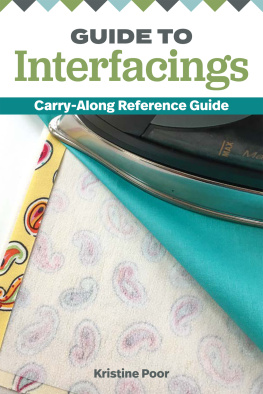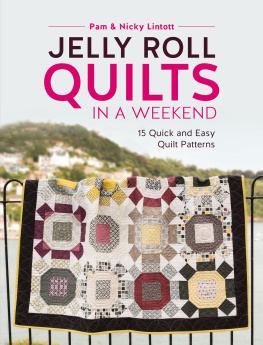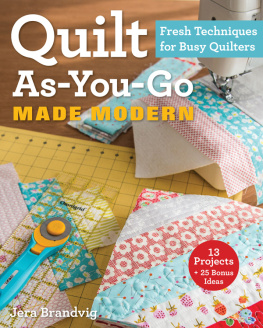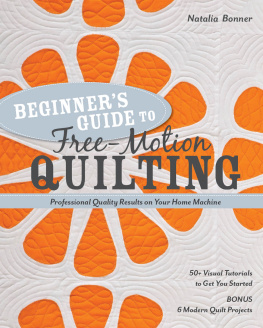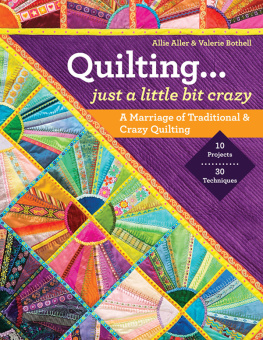Contents
Guide

Copyright 2020 by Krista Moser and Landauer Publishing, www.landauerpub.com, an imprint of Fox Chapel Publishing Company, Inc., 903 Square Street, Mount Joy, PA 17552.
Print ISBN: 978-1-947163-25-6
eISBN: 978-1-607657-99-6
Contents
History of Batting
Making batting was once very labor intensive. The cotton bolls were picked by hand by family or often slave labor. The cotton bolls had to be dried, with the seeds and debris removed by hand. It was then carded (combed) into small batts. The batts were placed between the layers of the quilt top and back, then very close hand quilting held the layers together.
Wool blankets and extra clothing were often substituted as batting. Eventually the invention of the cotton gin, which separated the cotton from its seeds, made cotton faster and easier to process.

Cotton gin, invented by Eli Whitney (1794)
Know Your Batting
Batting has come a long way from the leftover clothing and blankets women once used. There are so many options. Choose from cotton, cotton blends, polyester, wool, silk, and bamboo. There are various lofts, colors, and sizes to complement your quilt or craft project. Cotton, cotton blends, and polyester are the most popular.
Choose your batting according to the thickness and weight you want. Consider directions for care, cleaning, and shrinkage. Is this batting better for hand or machine quilting? How do you want your stitches to appear and how far apart can the quilting be? How thick or warm do you want the quilt to be? These are all questions easily answered with this handy booklet.
This little pocket guide is intended to give a general overview of the most common batting varieties available and the best uses for those listed. It is always a good idea to read the label on the batting you chose for that brands specific use and care information.
BATTING TERMINOLOGY
Bearding Batting fibers separate and may bleed or leak through the surface of a quilt between the fabric weave. This can be a problem with darker quilts as a lighter batting will beard through and leave a lint layer across the quilt. Its the most common with wool or silk batting.
Bleaching Some manufacturers make a bleached version of their battings for use in white or light quilts.
Bonded Batting treated with resins, glues, or heat fusing the fibers together. This process is often used to retard bearding or prevent fibers from bunching or shifting.
Drape Pliability of the finished project; soft, flexible, and form fitting.
Fusible Batting, stabilizer, or interfacing coated on one or both sides with dried glue or resin, which becomes an adhesive when heated.
Loft Thickness of the batting is called loft. Generally, the higher the loft the more open the fiber structure. Low-loft batting is thin and flat, high-loft batting is thicker and fluffy.
Needle-punched The batting fibers are layered up and then thousands of tiny needles are punched through the layers to fuse the fibers together. Sometimes the fibers are needle-punched to a scrim and sometimes they are just needle-punched together with no scrim.
Scrim A thin layer of woven fibers or mesh applied to the batting to keep the fibers from separating, moving, or lumping together. Often this scrim is made out of polyester.
FREQUENTLY ASKED QUESTIONS
Does Brand Matter?
Generally, batting makers who manufacture similar products are fairly interchangeable. Some, however, set themselves apart by sourcing better-quality goods or by using little or no chemicals in their processing. You can read more about each brands qualities on their websites.
How is Batting Rated?
Batting doesnt have a rating, per se. Of most common interest is how far apart the quilting can be, how thick the batting is, and how much each batting will shrink.
Which is the Perfect Batting for My Project?
This is dependent on the style of your project and the desired look. Here are some things to consider when looking for the best fit for each project.
Use of quilt Will this be a bed quilt, wall quilt, table setting, bag, or garment?
Laundering Will this be laundered frequently?
Warm or cool Will this be a winter or summer quilt project?
Appearance Do you want a thin or puffy look?
Fiber content Do you want natural fiber or synthetic?
Quilting Will this be hand- or machine-quilted, and how far apart do you plan your quilting stitches to be?
Does Batting Have a Right or Wrong Side?
Officially the answer is no, there is no right or wrong side to batting. That being said, batting does often look different from one side to the other; this is especially the case with needle-punched batting.
The needle-punching process dimples the top and punches out the back. Most quilters want their needle (whether hand or machine quilting) to go in the same direction as the batting was needle punched. This makes the dimpled side the side you put toward the quilt top. The back side (often needle-punched through scrim) is the side that goes against the backing. Having the scrim side against the backing will also help alleviate any bearding, or batting fibers, that might otherwise come through onto the backing.
How Do I Prewash Batting, and Is It Necessary?
Prewashing batting is not typically recommended, but certain battings can be prewashed safely if you want to mitigate as much post-quilting shrinkage as possible. This is especially the case with 100% cotton or cotton blend battings.
To safely prewash/preshrink, soak the batting in a clean bathtub with cool water and little or no detergent. Squeeze out excess moisture by rolling it in a dry towel and then lay it out flat to fully dry. Cotton batting with scrim can be soaked in the washing machine tub without using the agitator, then spun out to remove excess moisture. It can be air-fluffed for 510 minutes in the dryer, then laid out flat to dry completely. It is highly discouraged to prewash batting made with silk or wool.
CHOOSING THE BATTING
If the quilt top is 100% cotton, you probably want 100% cotton or another natural fiber batting. Cotton-blend batting, such as an 80/ 20 mix, is popular for bed quilts. Unless you plan to prewash the batting, you will want to ensure that the fibers shrink at the same rate as the top and backing fabrics.
TYPICAL BATTING MATERIALS
100% Cotton
Made from natural fibers, this type is soft and comfy. Its one of the most commonly chosen batting for all types of quilting and craft projects. 100% cotton batting tends to be very dense and flat.
Cotton Blends




